
Artificial Intelligence (AI) is evolving at a pace few could have imagined a decade ago. From powering your favorite virtual assistant to generating human-like content and making complex decisions autonomously, AI is no longer just a futuristic concept—it’s here and it’s reshaping our world.
With this rapid evolution comes new terminologies that even professionals sometimes struggle to distinguish—Agentic AI, AI Agents, and Generative AI. While these terms are often used interchangeably, they represent distinct paradigms within the AI landscape.
In this blog, we’ll break down what each of these concepts means, how they differ from one another, and why understanding their nuances is crucial for developers, business leaders, and AI enthusiasts alike.
What is Agentic AI?
Agentic AI refers to an advanced class of AI systems designed to autonomously pursue complex goals over extended timeframes. These systems don’t just respond to prompts; they plan, adapt, and self-direct their actions based on evolving circumstances.
Unlike typical AI systems that operate under strict user instructions, agentic AI systems exhibit traits like:
-
Autonomy – The ability to act without constant human input.
-
Goal-orientation – Operating with defined outcomes or missions.
-
Adaptability – Learning from the environment and dynamically adjusting strategies.
Real-World Example:
An agentic AI might be deployed to automatically manage an entire product launch, including conducting market research, identifying target audiences, generating content, adjusting strategies in real-time, and collaborating with other AI agents or humans to execute tasks.
According to a report by McKinsey, businesses that adopt autonomous AI systems could see a productivity increase of up to 40% by 2030 (McKinsey & Company).
What are AI Agents?
AI agents are software programs that act on behalf of a user to complete specific tasks. They can range from simple rule-based bots to complex decision-making systems powered by machine learning and deep learning.
Characteristics of AI Agents:
-
Task-specific – Designed to accomplish particular jobs (e.g., scheduling meetings, making recommendations).
-
User-driven – Often require human inputs or directives to operate.
-
Context-aware – Can understand their environment and respond accordingly.
Common AI Agent Examples:
-
Recommender systems (like those used by Netflix or Amazon)
-
Chatbots (like Intercom or Drift)
-
Autonomous navigation systems (e.g., in self-driving cars)
Unlike Agentic AI, AI agents do not initiate their own goals. They function within the scope of pre-set tasks and operate reactively rather than proactively.
What is Generative AI?
Generative AI refers to AI models capable of generating new content—text, images, audio, or even code—based on the data they’ve been trained on.
At the heart of this space are models like GPT-4 (by OpenAI), Bard (by Google), and Claude (by Anthropic). These models use deep learning techniques, especially transformer architecture, to mimic human creativity at scale.
Common Applications of Generative AI:
-
Content creation (blogs, social posts, marketing copy)
-
Code generation
-
Art and design
-
Video and music production
According to Statista, the global generative AI market is expected to reach $207 billion by 2030, up from $13 billion in 2023 (Statista)—highlighting its explosive growth trajectory.
Key Differences at a Glance
| Feature | Agentic AI | AI Agents | Generative AI |
|---|---|---|---|
| Autonomy | High (Self-directed) | Medium (User-directed) | Low (Prompt-dependent) |
| Goal-driven | Yes (Long-term goals) | Yes (Task-specific) | No (Not goal-driven) |
| Creativity | Medium | Low | High |
| Interaction Style | Proactive & autonomous | Reactive | Prompt-response |
| Use Case | End-to-end operations | Task automation | Content creation |
| Learning Capability | Continual learning | Contextual learning | Pattern recognition |
Why Agentic AI Represents the Next Frontier
While AI agents and generative AI have made waves, agentic AI is the real game-changer.
Think of it as the evolution from:
-
Doing what you say (Generative AI)
-
To doing what you need (AI Agent)
-
To figuring out what needs to be done and doing it (Agentic AI)
Key Advantages of Agentic AI:
-
Scalable Autonomy: Businesses can offload entire workflows to AI without micromanaging every detail.
-
Strategic Thinking: Agentic systems can break down complex goals into sub-goals and execute independently.
-
Multi-agent Collaboration: These systems can coordinate with other AI agents or humans to achieve broader objectives.
According to a16z (Andreessen Horowitz), agentic AI systems will be central to the next phase of AI infrastructure, potentially powering AI-native startups that need minimal human input (a16z).
Agentic AI in Action: Use Cases Across Industries
1. Marketing Automation
Imagine a campaign where the AI:
-
Researches competitors
-
Identifies trends
-
Writes and schedules posts
-
Analyzes metrics and optimizes the campaign—entirely on its own
2. Healthcare
Agentic AI could autonomously:
-
Monitor patient records
-
Identify early warning signs
-
Schedule appointments
-
Recommend interventions
3. Supply Chain Management
An AI that continuously:
-
Monitors global logistics
-
Predicts disruptions
-
Reroutes deliveries
-
Updates all stakeholders in real time
These aren’t distant dreams—they’re rapidly becoming reality.
Challenges and Ethical Considerations
While promising, agentic AI also raises critical concerns:
-
Accountability: Who is responsible if an autonomous AI makes a costly mistake?
-
Transparency: Can users understand and trust an AI that acts independently?
-
Control: How do we ensure the system remains aligned with human values?
Researchers and policymakers are actively working to define ethical frameworks to govern the deployment of agentic AI.
The OECD AI Principles stress the importance of human-centered values, transparency, and accountability in AI design (OECD).
Future Outlook: Convergence of AI Types
Though distinct, these AI categories aren’t mutually exclusive. In fact, the future of AI likely involves a synergistic blend of all three:
-
Generative AI as the creative brain,
-
AI Agents as the hands and eyes,
-
Agentic AI as the autonomous project manager.
This layered approach will give rise to truly intelligent systems—capable of ideating, executing, and evolving without human supervision.
Conclusion: Why You Should Care
Whether you’re a CTO, marketer, entrepreneur, or just an AI enthusiast, understanding the difference between agentic AI, AI agents, and generative AI is vital.
-
For businesses, adopting the right kind of AI could mean massive competitive advantages.
-
For developers, it’s about building smarter, more autonomous systems.
-
For society, it’s about preparing for a world where machines can think, plan, and act on their own.
Agentic AI isn’t just another buzzword—it’s the bridge between today’s reactive tools and tomorrow’s autonomous solutions.

